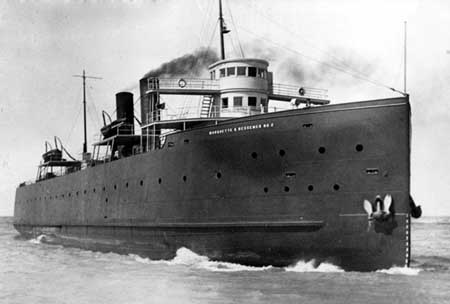Welcome
This website is a collection of history and memorabilia surrounding Marine and Ship Captains and Sailors who dedicated their lives to Great Lakes Shipping and Transport.
If you have anything to add, please feel free to email using the link at the bottom of every page.
Historical Facts Regarding the Great Lakes
Source: The Lake Pilots' Handbook, compiled by Capt. George Trimble, 1907
The First Ship On The Great Lakes
The first known ship to navigate the Great Lakes was the "Griffon," a little vessel of about sixty tons, built in 1679 by the French explorer, La Salle. This ship was launched into the Niagara River about the present site of the village of La Salle. On August 7th, 1679, the Griffon, loaded with supplies for a long trip of exploration, sailed up the lakes. Very little is recorded of the trip but the supposition is that the north shore of Lake Erie was followed until the entrance to the Detroit river was found, and on Lake Huron the west shore was followed to the Straits of Mackinac. Early in September the little ship had reached Green Bay. Here La Salle loaded her with furs that had been purchased from the Indians, and ordered his captain to take her back to Lake Erie. La Salle did not accompany the ship but with part of his men he started overland on his trip of exploration. The Griffon was never heard from afterward, no doubt having foundered in a gale with her entire crew.
The First Steamer Of The Great Lakes
The steamer "Walk-in-the Water," built in Buffalo in 1818, is generally spoken of as the first steamer to sail the Great Lakes, but, as a matter of fact, two steamers were built on Lake Ontario in 1616. These were the Canadian steamer Frontenac and the American steamer Ontario. But these boats were not looked upon as the first Great Lakes' steamers because their operations were confined to Lake Ontario. The "Walk-in-the-Water" measured 328 tons. The owners of the great steamboat thought none of the lake men would be capable of handling her and brought a master from the North river. This master promptly resigned his position after encountering one of Lake Erie's vicious sou'westers. A lake sailor was then placed in command. The "Walk-in-the-Water" was driven ashore in a gale on Lake Erie in 1821. Her engines were saved into the steamer Superior in 1822.
Other Facts Regarding the Great Lakes
The St. Lawrence river was discovered by the explorer Aubert in 1508. The French explorer Jacques Cartier ascended the St. Lawrence river as far as the Indian village of Hochelaga (now Montreal) in 1534.
Lake Huron was the first of the Great Lakes to be discovered. In 1615 the French explorers Le Caron and Champlain both discovered Lake Huron but in separate parties. Both explorers came up the St. Lawrence as far as Montreal and then up the Ottawa river. They then took different routes across the country to Georgian Bay and into Lake Huron. The exploring parties met in the Lake Huron region and joined forces. Lake Ontario was discovered the same year on the return trip.
Lake Erie was the last of the lakes to be discovered. Joliet discovered Lake Erie in 1669.
Lake Superior was discovered in 1629 by the French explorer Brule.
Lake Michigan was discovered in 1634 by the French explorer Nicolet.
The first recorded passage of the Detroit river by white man was in 1670 by two French priests.
The first white man to see the Niagara Falls is supposed to have been the explorer Brule.
The French explorer La Salle built the first vessel on the Great Lakes in 1679. This little vessel-the Griffon-is described on another page.
The first American vessel to be built on the Great Lakes was the "Washington," built at Erie (then Presque Isle) in 1797.
In 1812 a vessel called the "Fur Trader" was built on Lake Superior and after being used in the fur business for awhile she was run over the rapids at the Soo in the attempt to get her to the lower lakes. But she was almost completely wrecked in the attempt. Another little vessel, the Mink, was run over the rapids in 1817 and sustained but little damage.
A 96 ton brig was built for service on Lake Erie in 1814, but was soon laid up as being too big to successfully do business on the lakes.
The first steamer built on the Great Lakes was the "Ontario" built at Sacketts harbor in 1816. She was a vessel of 232 tons. The Canadian steamer "Frontenac" was built during the same year. But the first steamer built on Lake Erie, for up-lake service, was the "Walk-in-the-Water," built at Buffalo in 1818. The steamer is described on another page.
In 1826 the first steamer sailed on Lake Michigan.
Regular passenger service was established to Chicago in 1830.
In 1836 the first shipment came into Buffalo when the brig "John Kenzie" brought in 3,000 bushels of wheat.
The first steamers from Buffalo ventured only as far as Detroit.
The first locomotive used in Chicago was carried there in a sail vessel in 1837.
The first grain elevator was built in Buffalo in 1842.
The first steamer to use propellers instead of paddle wheels was the "Vandalia" built at Oswego in 1841.
The first steamer on Lake Michigan was the "Independence" in 1845. The Independence came from Chicago and was portaged around the Soo rapids.
